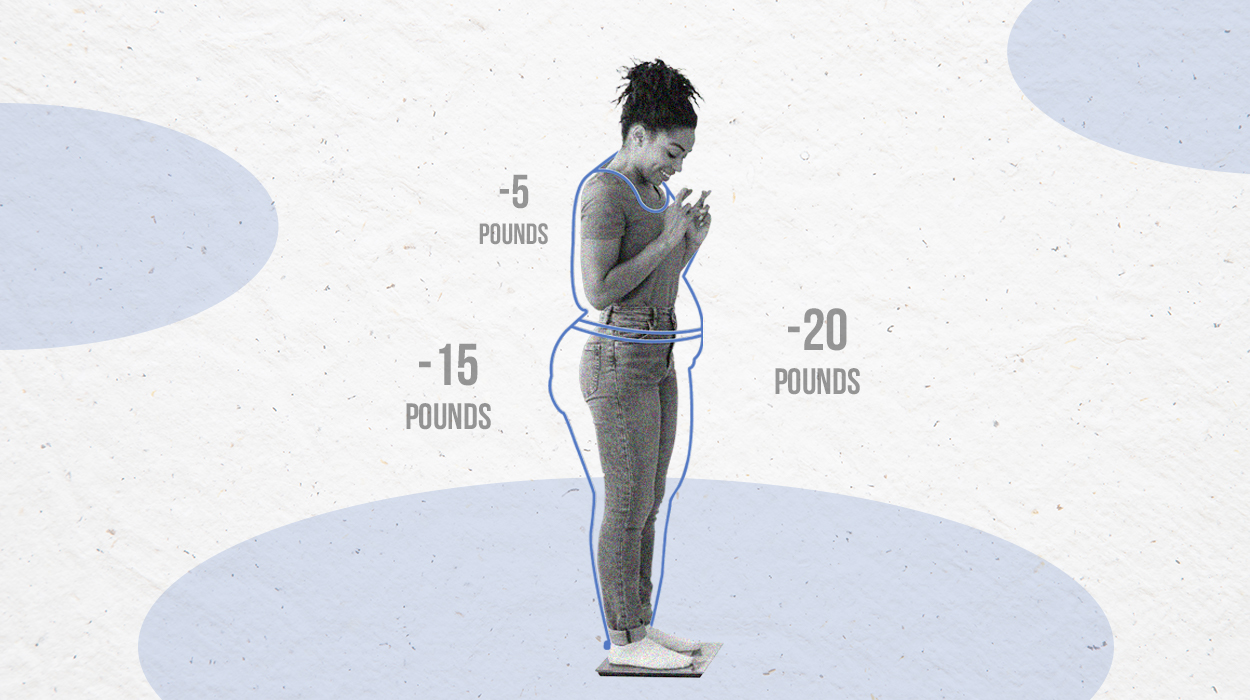 Expert's opinion
Expert's opinion
Expert's opinion
The article is a subjective view on this topic written by writers specializing in medical writing.
It may reflect on a personal journey surrounding struggles with an illness or medical condition, involve product comparisons, diet considerations, or other health-related opinions.
Although the view is entirely that of the writer, it is based on academic experiences and scientific research they have conducted; it is fact-checked by a team of degreed medical experts, and validated by sources attached to the article.
The numbers in parenthesis (1,2,3) will take you to clickable links to related scientific papers.
How Much Weight Loss Is Noticeable 2024? A Few Things You Need To Know

According to the Centers for Disease Control and Prevention,[1] the prevalence of obesity among Americans was 42.4% in 2017-2018. Nowadays, pretty much everyone is trying to lose those extra pounds and stay fit. Many people are interested in the question “How much weight loss is noticeable and makes you look different?”. The best feeling when people notice when you lose a few pounds, is it right? That probably will make your day or even a week. We know it takes blood, sweat, and tears to achieve weight loss. It does not matter how much weight you lose, but even when you shed only a few pounds, people still notice it. That motivates you to lose more weight. To have that best feeling, here is how much weight you need to lose.
How Much Weight Loss Is Noticeable?
Honestly, it depends on your BMI and body type. Your height and weight play a significant role here. However, on average, you would need to lose something in the range of 14 to 19 pounds to notice a difference in your weight. Think about it in percentages. You will start noticing the difference, as soon as you lose a minimum of 2% to 5% of your body weight. Focus on a weight loss regime that works slowly but surely, rather than going with the flashier ones which are not sustainable in the long run.
How Much Weight Do You Have To Lose To Notice?
We first notice the difference in initial weight loss through our faces. According to research, men and women of average height need to gain or lose about eight and nine pounds (three and a half to four kilograms) for anyone to notice the difference in face.
Furthermore, Canadian researchers also found that women need to shed slightly a few more pounds than men to look more attractive to people. And the average amount of shedding needed to make your face more appealing in photos, for an average woman of typical height is 14 pounds, and for men, it is 18 pounds.
The University of Toronto also stated that a person’s face is a robust indicator of their health. Increased facial adiposity is linked to a compromised immune system and cardiovascular function, stress levels, and more prone to frequent respiratory infections, blood pressure, and mortality. So, a few dropped pounds from a person’s face can help improve one’s health.

How Much Weight Is A Healthy Weight?
To know the amount of body fat one needs to lose, we first need to understand body mass index and its significance. Body mass index is a person’s body weight in kilograms divided by the square of height in meters. One can calculate it through a BMI index chart,[2] and set weight loss goals.
Healthy BMI ranges from 18.5 to 24.9. Now, you know how to figure out how much weight you need to lose. Follow a safe and effective weight loss strategy to improve one’s health. Most doctors agree with the fact that losing 1-2 pounds a week is ideal for sustainable weight loss.
Which Part Of The Body Fat Do We Lose Weight First?
This is one of the most asked questions when it comes to body-targeted weight loss. Where we lose weight first largely depends on several genetic factors. Just like our body is programmed to lose fat from certain body parts. Your diet, workout regime, sexual life, hormones, and age plays a vital role in how rapidly you can drop a few pounds.
If you have ever been on a weight loss journey before, you might be aware of where your body might be losing fat. For some, it might be the waistline to see the first weight changes. But for others, it could be the face or breasts. A study published,[3] recently found that women tend to lose more fat from their hips, whereas men tend to lose weight from their trunk area.
Furthermore, gaining and losing fat on certain body parts tend to change as you age. Postmenopausal women and middle-aged men tend to store fat around the midsections. A study involving female soldiers who were on an intense training program for 12 weeks found that they lost most of the fat from their arms and trunks, and the fat mass in their legs remained unchanged.
When Do People Notice Weight Loss?
There are various factors that affect our weight loss like diet and exercise. Although there are no evident answers about the rate of losing weight, here are some reasons and tips that one needs to consider to notice the lost weight.
Starting Size
Starting size can impact how fast the results would be noticeable. If you have a higher BMI to start with, weight fluctuation may not be evident on a large frame. And a larger body is more likely to lose weight faster. Significantly during the early days of weight loss, if you fall under a small frame with a lower BMI, weight may come down slowly, but it will be evident very soon. People with low BMI will have less weight to shed and it will come down at a slower rate at one to two pounds a week.
Diet Type
Few popular diets like Atkins and South Beach are designed in such a way that there would be accelerated weight change in the initial phase. Many diets also include intense food restrictions for the first and second week to drop some pounds in a short period. One can lose up to five or more pounds during this period. This helps you notice losing weight sooner. But you lose water weight here, due to restriction of carbohydrates, and not fat loss.
Carbohydrate Intake
As mentioned earlier, carbohydrate restriction can make you shed water weight too quickly. The body needs water to store carbohydrates. When you restrict carbohydrates, you lose water which is needed to store it. Losing water weight can make you look thinner, but the fat loss does not happen yet. Cutting on carbohydrates can help you lose weight but eating a healthy diet along with that can make a world of difference. It can land you in a healthy BMI soon and quickly get back in shape.
Measurement Method
When you get started with a weight loss plan, most of us want to fit into our favorite clothes that no longer fit us. Or perhaps, many want to have thinner thighs and killer abs. For some, numbers on the weighing machine mean a lot. After all, we want to be comfortable in our skin. Do you know that the way we measure progress can have an impact on our results? Firstly, you will most likely see changes on your scale. Secondly, on tight-fitting clothing. Whereas, some see changes in their belly, face, and thighs instantly. This could be genetic. But if you want to see changes in certain parts of your body, then exercise is your best friend. Exercise can change your frame. But remember, increased muscle mass can increase your weight even if you are losing fat. So focus on fat loss rather than numbers.
Size Changes In Clothing
If you are someone who looks forward to fitting into small-size clothes, then this is to brief you about how much weight you need to lose. Did you know that your height plays a huge role? Let’s say you are an average woman who is 5 feet tall, a 10-pound weight loss can be equal to losing 10% of body weight. People notice even a small decrease and you can size it down up to two sizes. But for tall and athletic women, a drop of 10 pounds may go unnoticed, and may not see a change in clothing size at all. Most experts say that one could expect your clothes to fit differently or change in clothing size with every 10 to 12 pounds of lost weight. Furthermore, weight changes do not happen evenly across the body. For example, your bra size may come down faster than your pant size.
Here Are A Few Things You Can Do To Notice Weight Difference In No Time

- Cut on sugars and salty foods completely.
- Eat a high-protein breakfast
- Practice mindful eating
- Drink water before meals
- Eat lots of soluble fiber
- Exercise along with a diet
- A good amount of probiotics
- Drink unsweetened black coffee and green tea
- Intermittent fasting
- A diet with whole foods
- Consume healthy fats
- Natural weight loss supplements for weight loss
Although most diets work based on permitting very fewer calories, they are not sustainable in the long run. In fact, you might gradually gain weight twice as much as you have lost. Faster shedding is unlikely to last as it is harder to maintain. Consume a healthy diet that consists of healthy fat content, proteins, and whole foods. Hire a personal trainer, as they understand our body better and with their help, you will notice a weight change in no time.
+ 3 sources
Health Canal avoids using tertiary references. We have strict sourcing guidelines and rely on peer-reviewed studies, academic researches from medical associations and institutions. To ensure the accuracy of articles in Health Canal, you can read more about the editorial process here
- Anon, (2023). Products – Data Briefs – Number 360 – February 2020. [online] Available at: https://www.cdc.gov/nchs/products/databriefs/db360.htm.
- CDC (2023). Assessing Your Weight . [online] Centers for Disease Control and Prevention. Available at: https://www.cdc.gov/healthyweight/assessing/index.html#:~:text=If%20your%20BMI%20is%20less,falls%20within%20the%20obese%20range.
- Benito, P.J., Rocío Cupeiro, Peinado, A.B., M. Angeles Rojo and Maffulli, N. (2017). Influence of previous body mass index and sex on regional fat changes in a weight loss intervention. [online] 45(4), pp.450–457. doi:https://doi.org/10.1080/00913847.2017.1380500.



